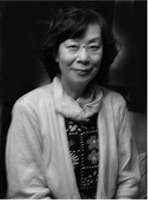Moto Hagio
| Moto Hagio 萩尾 望都 | |
|---|---|
|
Moto Hagio circa 2008. | |
| Born |
May 12, 1949 Ōmuta, Fukuoka, Japan |
| Nationality | Japanese |
| Area(s) | Writer, manga artist |
Notable works |
They Were Eleven Poe no Ichizoku A Cruel God Reigns |
| Awards | Tezuka Osamu Cultural Prize (1997) |
| Signature | |
 | |
Moto Hagio (萩尾 望都 Hagio Moto) is a manga artist born on May 12, 1949 in Ōmuta, Fukuoka Prefecture, Japan. She lives in Saitama Prefecture. She is considered a "founding mother" of modern shōjo manga, especially shōnen-ai. She is also a member of the Year 24 Group.[1] She has been described as "the most beloved shōjo manga artist of all time."[2] In addition to being an "industry pioneer", her body of work "shows a maturity, depth and personal vision found only in the finest of creative artists".[3]
Publishing career
Moto Hagio made her professional debut in 1969 at the age of 20 with her short story "Lulu to Mimi" in Nakayoshi.[4] Nakayoshi's publisher Kodansha wanted "bright and lively" works, and rival publisher Shogakukan sought her out.[5] Keiko Takemiya introduced Hagio to Takemiya's editor, Junya Yamamoto, who accepted all of Hagio's works that Kodansha had rejected.[6] When Hagio began drawing manga, she cut large sheets of "manga paper" to B4 size, and she still uses a G-Pen and a Maru-Pen. When she began drawing manga, she used India ink and a brush, but now uses Copic markers.[7] Later, for Shogakukan Publishing, she produced a series of short stories for various magazines. Two years after her debut, she published Juichigatsu no Gimunajiumu 11月のギムナジウム (The November Gymnasium), a short story that dealt openly with love between two boys at a boarding school. The story was part of a larger movement by female manga artists at the time that pioneered shōnen-ai, a genre of girls' comics about love between young men. In 1974, Hagio developed this story into the longer Thomas no Shinzō (The Heart of Thomas). She was awarded the Shogakukan Manga Award in 1976 for her science fiction classic Juichinin Iru! (They Were Eleven) and her epic tale Poe no Ichizoku (The Poe Family).[8] In the mid-1980s, Hagio wrote her first long work – Marginal.[9][10] Prior to writing Iguana Girl in 1991, Hagio had not set her works in contemporary Japan.[11] Moto Hagio had a role in the 2008 film Domomata no Shi (Death of Domomata).[12] On June 11, 2009, a party was held in Moto Hagio's honor, "celebrating her 40th year as a professional manga artist". Approximately 200 people attended.[13] In 2011, Joshibi University of Art and Design appointed Hagio as a guest professor.[14]
Personal life
Hagio is a science fiction fan, and considers Isaac Asimov, Arthur C. Clarke and Robert Heinlein to have influenced her,[5] and she has adapted several of Ray Bradbury's short stories from R is for Rocket into manga format.[15]
Works
- Ruru to Mimi, 1969
- Seireigari, 1971–1974
- 11-gatsu no Gymnasium, 1971
- Poe no Ichizoku, 1972–1976
- Tottemo Shiwase Moto-chan, 1972–1976
- Thomas no Shinzou (The Heart of Thomas), 1973–1975
- They were Eleven, 1975–1976
- Alois, 1975
- Hyaku Oku no Hiru to Sen oku no Yoru, 1977–1978
- Star Red, 1978–1979
- Mesh, 1980–1984
- Houmonsha, 1980
- A-A', 1981
- Hanshin, 1984
- Marginal, 1985–1987
- Flower Festival, 1988–1989
- Aoi Tori, 1989
- Umi no Aria, 1989–1991
- Roma e no Michi, 1990
- Abunai Oke no Ie, 1992–1994
- Zankokuna Kami ga Shihai suru, 1993–2001
- Barbara Ikai, 2002–2005
- Nanohana (Rape Blossoms), 2012[16]
- La Reine Margot,[17] 2012–
- Away, 2013
- Tenshi Kamoshirenai, 2016
Works in English
Few of her works appear in English, but here are some that do:
- A, A', which is out of print and includes three stories titled A, A' (A, A Prime), 4/4 (Quatre-Quarts), and X+Y parts one and two (all originally published in 1981).
- They Were Eleven (original date of publication 1975), which was part of the 1996 anthology Four Shōjo Stories. They Were Eleven is available on DVD as an anime, in both dubbed and subtitled formats. Like most anime based on manga, there are various minor changes and omissions.
- Hanshin (original date of publication 1984), a short story, which was published in issue 269 of The Comics Journal alongside an interview with Moto Hagio conducted by Matt Thorn.
- The Heart of Thomas (1973–1975), translated by Matt Thorn, published in a single-volume omnibus edition by Fantagraphics in 2013 .
A, A' and They Were Eleven have science fiction settings, and both They Were Eleven and X+Y include transgender elements. The science fiction aspects in particular have led to Hagio's work appealing to manga readers who do not generally like shōjo manga.
A 2010 anthology, A Drunken Dream and Other Stories, collects the following stories:[18]
- "Bianca" (1970)
- "Girl on Porch with Puppy" (1971)
- "Autumn Journey" (1971)
- "Marié, Ten Years Later" (1977)
- "A Drunken Dream" (1980)
- "Hanshin" (1984)
- "Angel Mimic" (1984)
- "Iguana Girl" (1991)
- "The Child Who Comes Home" (1998)
- "The Willow Tree" (2007)
These were selected by translator Matt Thorn to be a representative sample of her whole career,[19] with the input of a mixi fan club for Hagio.[7][20]
Video game works
Moto Hagio did the character designs for Quintet's video game Illusion of Gaia.
Awards
- 1976: 21st Shogakukan Manga Award for Poe no Ichizoku and They Were Eleven[8]
- 1980: 11th Seiun Award for Star Red[21]
- 1983: 14th Seiun Award for Gin no Sankaku[21] (Silver Triangle)
- 1985: 16th Seiun Award for X+Y[21]
- 1997: 1st Osamu Tezuka Cultural Prize (Award for Excellence) for Zankoku na kami ga shihai suru[22] (A Cruel God Reigns)
- 2006: 27th Nihon SF Taisho Award for Barbara Ikai[23] (Otherworld Barbara)
- 2010: Comic-Con's Inkpot Award[24]
- 2011: 40th Japan Cartoonists Association Awards: The Minister of Education, Culture, Sports, Science and Technology Award[25]
- 2012: First female manga creator to win Medals of Honor (Japan) with Purple Ribbon in honor of academic or artistic achievement[26]
References
- ↑ Thorn, Matt (2005). "A History of Manga". Animerica: Anime & Manga Monthly. 4 (2,4, & 6). Retrieved 2008-01-02.
- ↑ Thorn, Matt (February 1996). "Introduction". Four Shōjo Stories. Viz Communications. ISBN 1-56931-055-6.
- ↑ Deppey, Dirk. "The Comics Journal #269: Editor's Notes". The Comics Journal. 269. Archived from the original on August 5, 2010. Retrieved 2009-07-21.
- ↑ Randall, Bill (May 15, 2003). "Three by Moto Hagio". The Comics Journal. Retrieved 2010-08-05.
- 1 2 "Moto Hagio Focus Panel – San Diego Comic-Con 2010". Anime News Network. August 1, 2010. Retrieved 2010-08-05.
- ↑ Aoki, Deb. "Interview: Moto Hagio". About.com. The New York Times Company. p. 5.
- 1 2 Santos, Carlo. "A Conversation With Moto Hagio". Anime News Network.
- 1 2 小学館漫画賞:歴代受賞者 (in Japanese). Shogakukan. Retrieved 2007-08-19.
- ↑ Thorn, Matt. "The Hagio Moto Interview by Matt Thorn". Matt-thorn.com. Retrieved 2010-08-05.
- ↑ Ebihara, Akiko (2002). "Japan's Feminist Fabulation Reading Marginal with Unisex Reproduction as a Key Concept". 36. Genders.org. Retrieved 2010-08-05.
- ↑ Kawakatsu Miki. "Iguana Girl Turns Manga Legend" (PDF). Japanese Book News Vol. 63. Retrieved 2010-06-03.
- ↑ "Manga Creator Moto Hagio Makes Film Acting Debut". Anime News Network. August 1, 2010. Retrieved 2010-08-05.
- ↑ Thorn, Matt (June 20, 2009). "Matt Thorn's Blog · Moto Hagio Party, Handley update". Matt-thorn.com. Retrieved 2010-08-05.
- ↑ "Manga Creator Moto Hagio to Teach at Joshibi U.". Anime News Network.
- ↑ Thorn, Matt (July 30, 2010). "Matt Thorn's Blog · Comic-Con 2010 Report". Matt-thorn.com. Retrieved 2010-08-05.
- ↑ Long, Margherita (2014). "Hagio Moto’s Nuclear Manga and the Promise of Eco-Feminist Desire". Mechademia. 9 (1): 3–23. doi:10.1353/mec.2014.0003.
- ↑ "Moto Hagio to Launch New Manga Serialization in August". Anime News Network. 14 July 2012. Retrieved 10 December 2014.
- ↑ Thorn, Matt (March 9, 2010). "Matt Thorn's Blog · Moto Hagio collection, Takako Shimura's "Wandering Son"". Matt-thorn.com. Retrieved 2010-08-05.
- ↑ Garrity, Shaenon (July 27, 2010). "An Interview with Moto Hagio". The Comics Journal. Retrieved July 27, 2010.
- ↑ "Matt Thorn's Blog · Moto Hagio collection, Takako Shimura's "Wandering Son"". Matt-thorn.com. March 9, 2010. Retrieved 2012-08-13.
- 1 2 3 日本SFファングループ連合会議:星雲賞リスト (in Japanese). Retrieved 2007-12-31.
- ↑ Manga Award for Excellence: Hagio Moto "Zankoku na kami ga shihai suru" Exhibition
- ↑ "Nihon SF Taisho Award Winners List". Science Fiction and Fantasy Writers of Japan. Retrieved 2010-08-05.
- ↑ "Moto Hagio Receives Inkpot Award from Comic-Con Int'l". Anime News Network. July 23, 2010. Retrieved July 23, 2010.
- ↑ "40th Japan Cartoonist Awards Honor Moto Hagio". Anime News Network.
- ↑ "Hagio Is 1st Female Manga Creator to Win Japan's Purple Ribbon – News". Anime News Network. April 27, 2012. Retrieved 2012-08-13.
Further reading
- Silvester, Niko (February 7, 2011). "Creator Spotlight: Moto Hagio". Mania. Demand Media. Archived from the original on January 22, 2013.
External links
- Moto Hagio Titles – list of works
- Moto Hagio at Anime News Network's encyclopedia
- Cafe Bleu
- Interview at Journal du Japon (in French)
